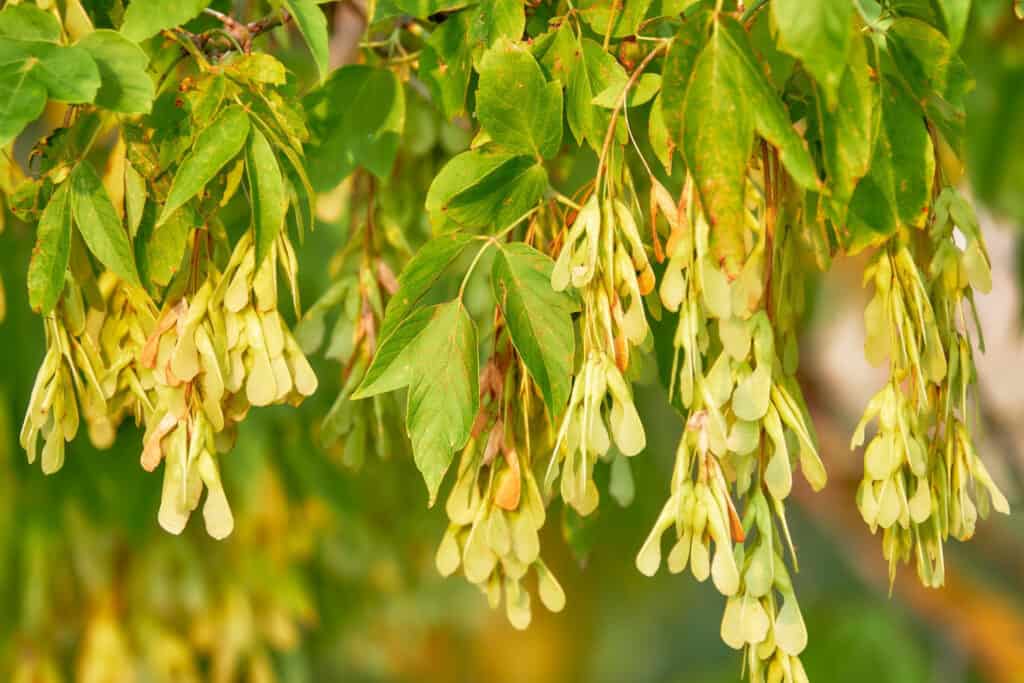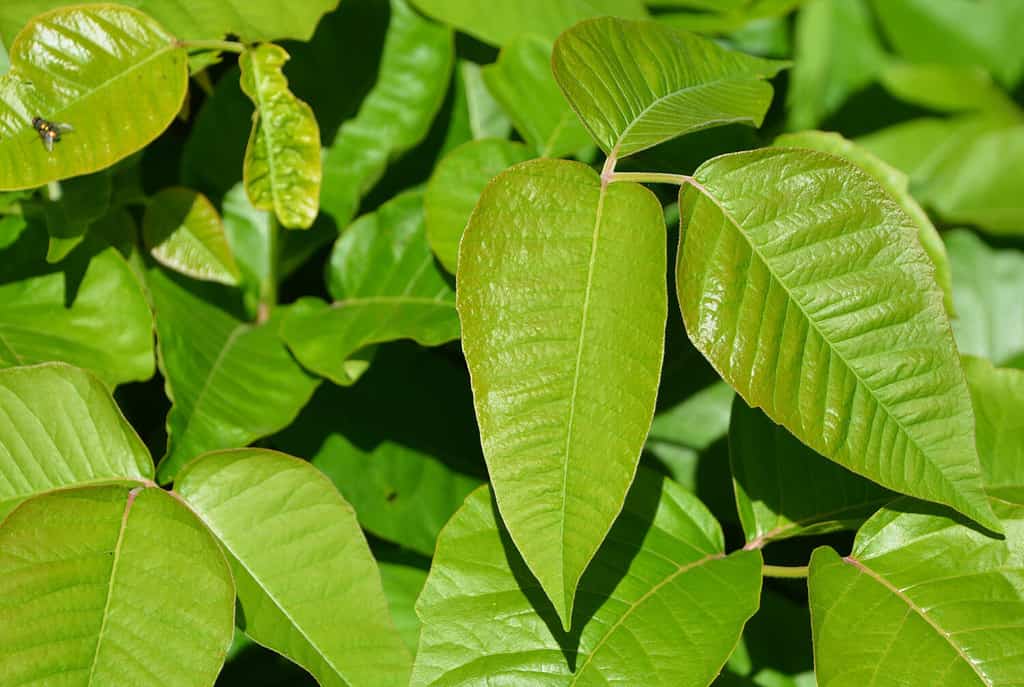Knowledge about your environment is one of the best safety practices you can hold to when interacting with it. The world is full of beautiful things, but it is also ripe with dangers and irritations. Among these dangers and irritations are plants. Several species of plants are poisonous or toxic, sometimes to humans and sometimes to livestock. By being able to pick out and identify dangerous plants, you can protect yourself and your wards when existing out in the great big world.
Some plants are dangerous for many reasons. A lot of plants look visually similar to one another, increasing the risk of touching or ingesting poisonous and toxic plants. This is true of box elder vs. poison ivy. We’re going to explore the differences and similarities between these two plants. We’ll take a look at how and where each plant grows, learn if it is poisonous or toxic, and discover what to do if you see or come in contact with it.
What is Box Elder?

A box elder tree can reach heights of 70 feet but averages 30-50 in maturity.
©BestPhotoStudio/Shutterstock.com
Box elder (Acer negundo) is a tree native to the United States. It is actually a species of maple tree, and it has many names. Here’s a list of just a few of them.
- Manitoba maple
- Ash-leaved maple
- Boxelder maple
- Sugar ash
- California maple
A box elder tree can reach heights of 70 feet but averages 30-50 in maturity. It has a rounded and irregular crown and fairly weak wood. The wood is weak due to its fast-growing nature. Other, slower-growing trees will have much stronger wood. The box elder grows in nearly all of the United States, excluding Alaska and Hawaii.
What is Poison Ivy?

Poison ivy is easy to identify by its cluster of three leaves.
©meunierd/Shutterstock.com
Poison ivy (Toxicodendron radicans) is an allergenic plant native to Asia and North America. The plant grows in three different ways – as a vine, as a shrub, or as a small plant. Poison ivy is easy to identify by its cluster of three leaves, thus the rhyme, “leaves of three, let it be” that serves as a warning to stay away from the toxic plant.
In the photo above, you can observe a red tint to the leaves of the poison ivy plant, along with a light shine. These are classic traits of most poison ivy plants. The plant blooms from May to July, offering a show of small, green, flower clusters. Poison ivy often turns red as fall approaches and bears small, white berries. It is a perennial plant, growing back in larger and thicker patches every year. It grows in all of the United States except for Alaska and Hawaii. The plant prefers moist, wooded areas or dense thickets.
Do Poison Ivy and Box Elder Really Look the Same?
Mature box elder trees do not look anything like any variety of poison ivy. However, the young tree sprouts often resemble poison ivy. A very young box elder plant grows close to the ground, and bears three green leaves. The shape and size of box elder at this age looks very similar to poison ivy, which is why people get them confused so often.
Box Elder vs. Poison Ivy – How to Tell the Difference
It’s pretty easy to tell the difference between young box elder vs. poison ivy, once you know what you’re looking for. First, consider the color of both plants. A young box elder is a shade of light green to bright green, while poison ivy has a light reddish-yellow tinge to its leaves. You can also note that the leaves on poison ivy are alternate, while the leaves on box elder are opposite.
If you need one more clue to be sure, look for the signature shine of poison ivy. These three clues will help you decide which is which.

A very young box elder plant grows close to the ground and bears three green leaves that look similar to poison ivy.
©CampSmoke/Shutterstock.com
Box Elder vs. Poison Ivy – Are They Toxic?
Poison ivy contains a mixture of organic compounds called urushiol. This compound has an irritating and allergenic effect when it comes into contact with human skin. It causes a rash that itches and sometimes hurts. This rash, known as urushiol-induced dermatitis, develops over several days and lasts for up to three weeks. Some people have more severe reactions to the rash. Poison ivy is toxic because of the urushiol it produces. It is best to avoid contact with or ingestion of poison ivy.
Box elder is not toxic to humans. You can touch it with no reaction, and some people believe it makes a great climbing tree. However, the seeds of box elder trees contain a toxic called hypoglycin A. These seeds are toxic to horses, causing a condition called Seasonal Pasture Myopathy (SPM). SPM is deadly to horses and has a very high fatality rate (75-95 percent). This condition causes difficulty walking, stiffness, dark urine, and death. Horses do not usually eat box elder or its seeds, but sparse pastures can drive them to partaking in the deadly snack. Because it is only toxic to horses, we will say box elder trees are not toxic.
| Plant Name | Nativity | Toxic/Poisonous? | Invasive? |
|---|---|---|---|
| Box Elder | North America | No | No |
| Poison Ivy | North America and Asia | Yes | No |
Preventing and Treating Poison Ivy
We will not include a full section on the treatment of box elder. It does not impact humans, and diagnosis and treatment of SPM in horses is a severe medical issue that requires an equine vet. If you suspect your horse has consumed toxic portions of the box elder tree, call your vet immediately. Prevention includes making sure your pastures have no mature box elder trees in them.
Preventing poison ivy is simple. Avoid patches of poison ivy when you are outdoors. Wear long pants while hiking in rugged areas that contain lots of poison ivy. Keep your pets out of poison ivy patches – while they are not susceptible to poison ivy, they can pass the urushiol to your skin.
Skin that has come in contact with poison ivy plants should be immediately treated. Wash the exposed area with cold water and dish soap. Dish soap is a great option because it is a degreaser and will free your skin from the oils that cause the rash. It is important to use cold water to keep the oils on the surface of your skin. Hot water will cause the oils to absorb into your skin more quickly.
If you contract a rash, keep it clean and dry and do not scratch it. You can use topical drying lotions such as calamine lotion to help dry up the rash sooner. A poison ivy rash is not contagious and it will go away on its own in a few weeks. Talk to your physician if you have a severe reaction.
Poison Ivy Uses
Some people think poison ivy has a homeopathic use, but we cannot recommend interacting with it more than you have to. There is no research that back up the use of poison ivy as a homeopathic remedy of any sort. However, it does have a use.
Poison ivy is just another fresh ingredient in nature’s salad bar. Bears, elk, white-tail deer, rabbits, and muskrats all eat the plant! They have no allergic reaction to the urushiol in the plant, and some consume every portion of the poison ivy plant. It may not be nice for us, but it’s good to know that it acts as food for our local wildlife.
Box Elder Uses
Box elder isn’t a very strong wood, but it still has its uses. In lumber, it is made into wood pulp. Wood pulp is used to make tissues, books, car filters, renewable fuel, stickers, and cardboard. Box elder also has use in small, ornamental woodcarving works.
Thank you for reading! Have some feedback for us? Contact the AZ Animals editorial team.








